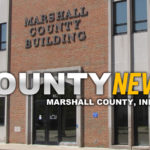Wednesday morning the Marshall County Commissioners and Council members held a joint work session about roads. County Highway Superintendent Jason Peters presented a PowerPoint presentation on roads.
Peters prevented information on a variety of topics. Going back to the beginning, in 2015 when many of the county roads were severely damaged due to the freeze and thaw. There were over 100 miles of roads that were closed or had hazard signs posted on them. This damage set the county back on road work, negatively affecting the estimated service life of many roads. Repair work was estimated at $750,000.

In 2018 there was a historical flooding event, and the county still hadn’t received from the 2015 incident. There were almost 200 miles of county roads that were closed or posted with high water signage. Fifteen bridges were damaged and needed repairs and many culverts, tiles, and ditches were impacted and had to be repaired or replaced. This incident again impacted the estimated service life of the county roads.

At this same time, PAR Electric was crossing the county installing the new electric poles and lines. The heavy trucks and equipment damaged many county roadways.
The PASER Ratings in 2015 showed 698 miles of county road were rated as failed, 112 miles were fair and only 10 miles were rated good. In 2018 the PASER Ratings showed 70% of the county’s roads were poor, 20% were fair and 10% were good. Looking at last year’s ratings, 30% of the county’s roads were rated poor, 39% were rated fair and 31% were rated good.

Peters said to have future success the highway department needs sustainable funding without exceeding the revenues being received. He said, “Collaboration, funding, and support are the keys to long-term future success.” Peters said the county needs to improve about 100 miles a year to stay on a 10-year turn and get to more preservation of roads. He also told the group the highway department needs to work from the top to the bottom instead of the bottom to the top, meaning maintaining roads that are in good shape and then addressing the bad roads as time and finances allow.
Peters explained his funding sources with the Motor Vehicle Highway Fund (MVH) bringing in $4.2 to $4.6 million annually and Local Roads and Streets (LRS) is about $800,000 each year. That gives him $3.8 to $4 million per year. For a 100-mile road program with 75 miles of chip seal, 20 miles of pug paving, 5 miles of hot mix asphalt, and the miscellaneous materials needed the cost average is $3.85 million. Peters said between the MVH and LRS funds, he budgets about $1.4 to $1.5 million for road projects so he is short about $2 million each year.

Peters reminded the county and commissioners that his funding not only takes care of roads but also includes salaries, benefits, equipment, fuel, insurance, and more. He said while MVH and LRS revenues have increased each year, so have the costs of materials.
The highway superintendent showed how they could do more with less using the cold mix paving which is about a 4 to 1 compared to hot mix paving. Using recycled materials such as asphalt and concrete is about a 3 to 1 cost difference and so is making cold-patch in-house. As an example, the superintendent said 1 mile of new asphalt paving is equal to 13 miles of chip and seal roads.
Speaking on funding Peters said in 2019 the split for MVH fund had the county receiving 48% of what was collected by the state. The state’s share was 52%. The present-day split gives the state 62% and the county gets 38%.












